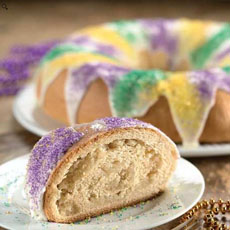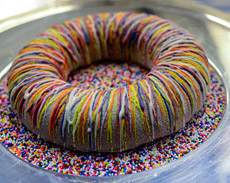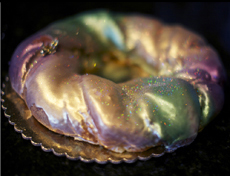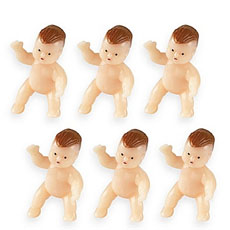Mardi Gras King Cake Kit & King Cake History
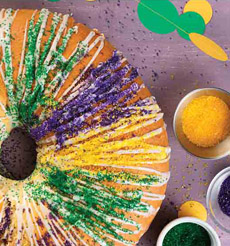 [1] Here’s what you can make from the King Cake Kit (photos #1 and #2 © King Arthur Flour).
|
Egad: It’s a perfect storm of food holidays! In 2016, the Super Bowl is February 7th, Lunar New Year begins February 8th, Mardi Gras follows on February 9th, and Valentine’s Day is February 14th. We’re tackling them one by one. Hundreds of thousands of King Cakes are eaten in Louisiana during the Carnival season: at home, in offices, and at King Cake parties. While people in other parts of the country may order a King Cake from a baking company in Louisiana, making your own with a King Arthur baking kit is likely to be tastier, not to mention less expensive and more fun. This easy King Cake kit from King Arthur Flour lets you celebrate in style. It has everything you need to make an impressive King Cake. You can even host a King Cake party, as many do in Louisiana. Editor’s Note 2023: The King Cake Kit is discontinued, but check out this recipe from King Arthur Flour. > The history of king cake below. What’s included: The kit is $19.95 at KingArthurFlour.com. |
|
|
THE HISTORY OF KING CAKE The King Cake is an adaptation of the French Epiphany Cake. While an Epiphany Cake is subdued—a round of crisp brown pastry—the celebration cakes in New Orleans are decorated in the three official colors of Mardi Gras: purple, green, and gold*. The cake is named for the three Wise Men, also called Magi or Kings. In France, the Epiphany Cake is called galette des rois, king cake. The King Cake tradition is believed to have arrived in New Orleans around 1870. In France, puff pastry (pâte à choux) is filled with almond cream (frangipane). But in New Orleans, the concept took another direction. The first King Cakes for Mardi Gras were simple rings of yeast dough, some braided, with a small amount of decoration. The flavor was mostly in the sweet toppings. The cakes became more festive over time, incorporating the Mardi Gras colors. Beginning in the late 1980s, customers sought something a bit more special: rich, brioche-like dough, filled with cream cheese filling. In more recent years, the fillings have followed modern tastes. You can find them in chocolate, numerous fruit flavors, and pralines. Royal icing with the three official colors of sparkling sugar decorates the tops. Shapes have evolved, too: round, oval, square, and at fine restaurants, deconstructed. There are also cookies, cupcakes, and macarons in purple, green, and gold. The ubiquitous cakes range from garish supermarket options to elegant pastries from the best bakers. The cake traditionally includes a small plastic baby representing Baby Jesus. The person who gets the piece of cake with the baby is said to have good luck for the next year. Note, however, that the lucky trinket has various privileges and obligations, which can include hosting next year’s party—or at least, bringing the cake. After the rich Danish dough is braided and baked, the “baby” is inserted. The top of the ring or oval cake is then covered with delicious sugar toppings in the Mardi Gras colors. Today, a tiny plastic baby is the common “prize.” At a party, the King Cake is sliced and served. Everyone looks to see if their piece contains the “baby.” If so, then that person is named “King” for a day and bound by custom to host the next party—and provide the King Cake. Other trinkets such as coins and charms could be baked into the cake. In humbler homes, a pecan, pea, or bean could be baked in. Since no one should bake plastic inside a cake, a plastic baby or other trinket is typically inserted through the underside of the cake after it’s baked. Trinket or not, we look forward to a big slice of our King Arthur King Cake. |
|
|
|
________________________________________ *The colors were selected in 1872 to honor the visiting Russian Grand Duke Alexis Alexis Alexandrovich Romanoff, whose house colors were purple, green, and gold. Purple signifies justice, green represents faith and gold is for power. |
||
